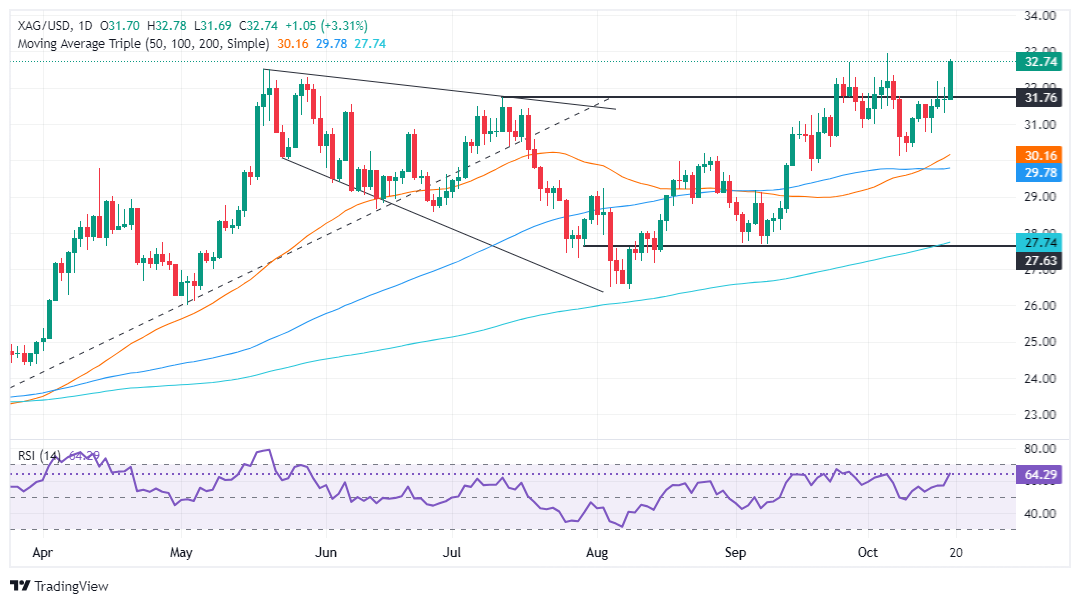Silver Price Forecast: XAG/USD skyrockets as buyers eye $33.00
- Silver surges past $32.00, driven by falling US Treasury yields, with prices up 2.26% during the North American session.
- The RSI indicates growing bullish momentum, with key resistance levels at $32.95 and $33.00 in sight.
- A pullback below $32.00 could see support at $31.32, with stronger backing around the 50-DMA at $30.13.
Silver's price skyrocketed during the North American session, sponsored by falling US Treasury bond yields. Even though traders trimmed bets that the Federal Reserve would ease policy less aggressively than expected, precious metals extended their gains. The XAG/USD trades at $32.33, up over 2.26%.
XAG/USD Price Forecast: Technical outlook
Silver’s price uptrend remains intact, at the brisk of registering a yearly record high. Earlier in the session, XAG/USD cleared the $32.00 psychological barrier and has extended its gains past the $32.50 area.
The Relative Strength Index (RSI) is bullish, aiming higher, indicating buyers are gathering steam.
Given the backdrop, the XAG/USD key resistance levels would be the year-to-date (YTD) high at $32.95, followed by the $33.00 mark. Once it is exceeded, the next stop would be October 1, 2012, peaking at $35.40.
Conversely, if XAG/USD retreats below $32.00, the first support would be the October 17 swing low of $31.32, followed by the confluence of the October 8 low and the 50-day moving average (DMA) at $30.13
XAG/USD Price Action – Daily Chart

Silver FAQs
Silver is a precious metal highly traded among investors. It has been historically used as a store of value and a medium of exchange. Although less popular than Gold, traders may turn to Silver to diversify their investment portfolio, for its intrinsic value or as a potential hedge during high-inflation periods. Investors can buy physical Silver, in coins or in bars, or trade it through vehicles such as Exchange Traded Funds, which track its price on international markets.
Silver prices can move due to a wide range of factors. Geopolitical instability or fears of a deep recession can make Silver price escalate due to its safe-haven status, although to a lesser extent than Gold's. As a yieldless asset, Silver tends to rise with lower interest rates. Its moves also depend on how the US Dollar (USD) behaves as the asset is priced in dollars (XAG/USD). A strong Dollar tends to keep the price of Silver at bay, whereas a weaker Dollar is likely to propel prices up. Other factors such as investment demand, mining supply – Silver is much more abundant than Gold – and recycling rates can also affect prices.
Silver is widely used in industry, particularly in sectors such as electronics or solar energy, as it has one of the highest electric conductivity of all metals – more than Copper and Gold. A surge in demand can increase prices, while a decline tends to lower them. Dynamics in the US, Chinese and Indian economies can also contribute to price swings: for the US and particularly China, their big industrial sectors use Silver in various processes; in India, consumers’ demand for the precious metal for jewellery also plays a key role in setting prices.
Silver prices tend to follow Gold's moves. When Gold prices rise, Silver typically follows suit, as their status as safe-haven assets is similar. The Gold/Silver ratio, which shows the number of ounces of Silver needed to equal the value of one ounce of Gold, may help to determine the relative valuation between both metals. Some investors may consider a high ratio as an indicator that Silver is undervalued, or Gold is overvalued. On the contrary, a low ratio might suggest that Gold is undervalued relative to Silver.

